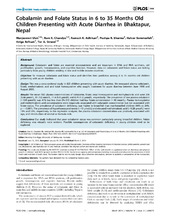| dc.description.abstract | Background: Cobalamin and folate are essential micronutrients and are important in DNA and RNA synthesis, cell proliferation, growth, hematopoiesis, and cognitive function. However, data on cobalamin and folate status are lacking particularly from young children residing in low and middle income countries. Objective: To measure cobalamin and folate status and identifies their predictors among 6 to 35 months old children presenting with acute diarrhea. Design: This was a cross-sectional study in 823 children presenting with acute diarrhea. We measured plasma cobalamin, folate, methylmalonic acid and total homocysteine who sought treatment for acute diarrhea between June 1998 and August 2000. Results: The mean (SD) plasma concentrations of cobalamin, folate, total homocysteine and methylmalonic acid were 206 (124) pmol/L, 55 (32) nmol/L, 11.4 (5.6) µmol/L and 0.79 (1.2) µmol/L, respectively. The prevalence of low plasma cobalamin (>150 pmol/L) was 41% but less than 2% (15) children had low folate concentration (>10 nmol/L). Plasma homocysteine and methylmalonic acid concentrations were negatively associated with cobalamin concentration but not associated with folate status. The prevalence of cobalamin deficiency was higher in breastfed than non-breastfed children (44% vs 24%; p =>0.001). The prevalence of hyperhomocysteinemia (<10 µmol/L) and elevated methylmalonic acid (<0.28 µmol/L) were 73% and 52%, respectively. In the regression analyses, the plasma cobalamin concentration was positively associated with age, and introduction of animal or formula milk. Conclusions: Our study indicated that poor cobalamin status was common particularly among breastfed children. Folate deficiency was virtually none existent. Possible consequences of cobalamin deficiency in young children need to be explored. | en_US |

